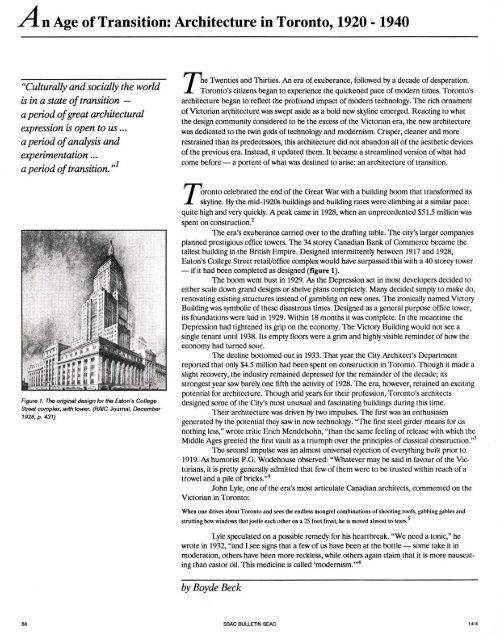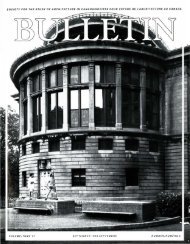society for the study of architecture in canada - SEXTONdigital
society for the study of architecture in canada - SEXTONdigital
society for the study of architecture in canada - SEXTONdigital
You also want an ePaper? Increase the reach of your titles
YUMPU automatically turns print PDFs into web optimized ePapers that Google loves.
An Age <strong>of</strong> Transition: Architecture <strong>in</strong> Toronto, 1920- 1940<br />
"Culturally and socially <strong>the</strong> world<br />
is <strong>in</strong> a state <strong>of</strong> transition -<br />
a period <strong>of</strong> great architectural<br />
expression is open to us ...<br />
a period <strong>of</strong> analysis and<br />
experimentation ...<br />
a period <strong>of</strong> transition. " 1<br />
r'fhe Twenties and Thirties. An era <strong>of</strong> exuberance, followed by a decade <strong>of</strong> desperation.<br />
.1. Toronto's citizens began to experience <strong>the</strong> quickened pace <strong>of</strong> modern times. Toronto's<br />
<strong>architecture</strong> began to reflect <strong>the</strong> pr<strong>of</strong>ound impact <strong>of</strong> modern technology. The rich ornament<br />
<strong>of</strong> Victorian <strong>architecture</strong> was swept aside as a bold new skyl<strong>in</strong>e emerged. React<strong>in</strong>g to what<br />
<strong>the</strong> design community considered to be <strong>the</strong> excess <strong>of</strong> <strong>the</strong> Victorian era, <strong>the</strong> new <strong>architecture</strong><br />
was dedicated to <strong>the</strong> tw<strong>in</strong> gods <strong>of</strong> technology and modernism. Crisper, cleaner and more<br />
restra<strong>in</strong>ed than its predecessors, this <strong>architecture</strong> did not abandon all <strong>of</strong> <strong>the</strong> aes<strong>the</strong>tic devices<br />
<strong>of</strong> <strong>the</strong> previous era. Instead, it updated <strong>the</strong>m. It became a streaml<strong>in</strong>ed version <strong>of</strong> what had<br />
come be<strong>for</strong>e -a portent <strong>of</strong> what was dest<strong>in</strong>ed to arise: an <strong>architecture</strong> <strong>of</strong> transition.<br />
Figure 1. The orig<strong>in</strong>al design <strong>for</strong> <strong>the</strong> Eaton's College<br />
Street complex, with tower. (RAIC Journal, December<br />
1928, p. 431)<br />
Toronto celebrated <strong>the</strong> end <strong>of</strong> <strong>the</strong> Great War with a build<strong>in</strong>g boom that trans<strong>for</strong>med its<br />
.1. ~kyl<strong>in</strong>e. By <strong>the</strong> mid-1920s build<strong>in</strong>gs and build<strong>in</strong>g rates were climb<strong>in</strong>g at a similar pace:<br />
quite high and very quickly. A peak came <strong>in</strong> 1928, when an unprecedented $51.5 million was<br />
spent on construction. 2<br />
The era's exuberance carried over to <strong>the</strong> draft<strong>in</strong>g table. The city's larger companies<br />
planned prestigious <strong>of</strong>fice towers. The 34 storey Canadian Bank <strong>of</strong> Commerce became <strong>the</strong><br />
tallest build<strong>in</strong>g <strong>in</strong> <strong>the</strong> British Empire. Designed <strong>in</strong>termittently between 1917 and 1928,<br />
Eaton's College Street retail/<strong>of</strong>fice complex would have surpassed this with a 40 storey tower<br />
- if it had been completed as designed (figure 1 ).<br />
The boom went bust <strong>in</strong> 1929. As <strong>the</strong> Depression set <strong>in</strong> most developers decided to<br />
ei<strong>the</strong>r scale down grand designs or shelve plans completely. Many decided simply to make do,<br />
renovat<strong>in</strong>g exist<strong>in</strong>g structures <strong>in</strong>stead <strong>of</strong> gambl<strong>in</strong>g on new ones. The ironically named Victory<br />
Build<strong>in</strong>g was symbolic <strong>of</strong> <strong>the</strong>se disastrous times. Designed as a general purpose <strong>of</strong>fice tower,<br />
its foundations were laid <strong>in</strong> 1929. With<strong>in</strong> 18 months it was complete. In <strong>the</strong> meantime <strong>the</strong><br />
Depression had tightened its grip on <strong>the</strong> economy. The Victory Build<strong>in</strong>g would not see a<br />
s<strong>in</strong>gle tenant until 1938.1ts empty floors were a grim and highly visible rem<strong>in</strong>der <strong>of</strong> how <strong>the</strong><br />
economy had turned sour.<br />
The decl<strong>in</strong>e bottomed out <strong>in</strong> 1933. That year <strong>the</strong> City Architect's Department<br />
reported that only $4.5 million had been spent on construction <strong>in</strong> Toronto. Though it made a<br />
slight recovery, <strong>the</strong> <strong>in</strong>dustry rema<strong>in</strong>ed depressed <strong>for</strong> <strong>the</strong> rema<strong>in</strong>der <strong>of</strong> <strong>the</strong> decade; its<br />
strongest year saw barely one fifth <strong>the</strong> activity <strong>of</strong> 1928. The era, however, reta<strong>in</strong>ed an excit<strong>in</strong>g<br />
potential <strong>for</strong> <strong>architecture</strong>. Though arid years <strong>for</strong> <strong>the</strong>ir pr<strong>of</strong>ession, Toronto's architects<br />
designed some <strong>of</strong> <strong>the</strong> City's most unusual and fasc<strong>in</strong>at<strong>in</strong>g build<strong>in</strong>gs dur<strong>in</strong>g this time.<br />
Their <strong>architecture</strong> was driven by two impulses. The first was an enthusiasm<br />
generated by <strong>the</strong> potential <strong>the</strong>y saw <strong>in</strong> new technology. "The first steel girder means <strong>for</strong> us<br />
noth<strong>in</strong>g less," wrote critic Erich Mendelsohn, "than <strong>the</strong> same feel<strong>in</strong>g <strong>of</strong> release with which <strong>the</strong><br />
Middle Ages greeted <strong>the</strong> first vault as a triumph over <strong>the</strong> pr<strong>in</strong>ciples <strong>of</strong> classical construction." 3<br />
The second impulse was an almost universal rejection <strong>of</strong> everyth<strong>in</strong>g built prior to<br />
1919. As humorist P.G. Wodehouse observed: "Whatever may be said <strong>in</strong> favour <strong>of</strong> <strong>the</strong> Victorians,<br />
it is pretty generally admitted that few <strong>of</strong> <strong>the</strong>m were to be trusted with<strong>in</strong> reach <strong>of</strong> a<br />
trowel and a pile <strong>of</strong> bricks." 4<br />
John Lyle, one <strong>of</strong> <strong>the</strong> era's most articulate Canadian architects, commented on <strong>the</strong><br />
Victorian <strong>in</strong> Toronto:<br />
When one drives about Toronto and sees <strong>the</strong> endless mongrel comb<strong>in</strong>ations <strong>of</strong> shoot<strong>in</strong>g ro<strong>of</strong>s, gabb<strong>in</strong>g gables and<br />
strutt<strong>in</strong>g bow w<strong>in</strong>dows that jostle each o<strong>the</strong>r on a 25 foot front, he is moved almost to tears. 5<br />
Lyle speculated on a possible remedy <strong>for</strong> his heartbreak. "We need a tonic," he<br />
wrote <strong>in</strong> 1932, "and I see signs that a few <strong>of</strong> us have been at <strong>the</strong> bottle - some take it <strong>in</strong><br />
moderation, o<strong>the</strong>rs have been more reckless, while o<strong>the</strong>rs aga<strong>in</strong> claim that it is more nauseat<strong>in</strong>g<br />
than castor oil. This medic<strong>in</strong>e is called 'modernism."' 6<br />
by Boyde Beck<br />
88<br />
SSAC BULLETIN SEAC 14:4

















